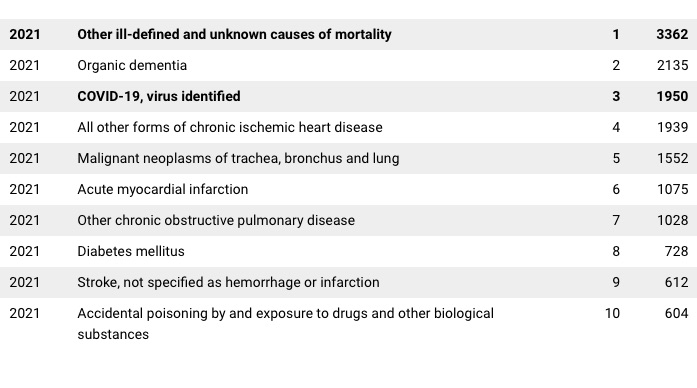COVID-19
Leading cause of death in Alberta (BY A LONG SHOT) is “Unknown”. Why isn’t our next Premier talking about this?

If you were to ask 10 random Albertans what the leading cause of death was in 2021, many would respond with either COVID-19, or perhaps cancer. If they really pay attention to things like this they might say heart disease or maybe dementia (old age).
Lucky for us the Province of Alberta has made the cause of death statistics public since 2001. If you’d like to see them, click here and download “Leading Causes of Death”. If you do, you’ll see that for 15 years in a row, from 2001 to 2015 the leading cause of death for Albertans was heart disease. Dementia makes a strong push toward the end of that time frame. By 2016 dementia became the leading cause of death for the next 5 years in a row. Here’s what the list of the top 10 causes of death looked like in 2019. That was the last year ‘before’ COVID-19 appeared on the list.
| 2019 | Organic dementia | 1 | 1997 |
| 2019 | All other forms of chronic ischemic heart disease | 2 | 1886 |
| 2019 | Malignant neoplasms of trachea, bronchus and lung | 3 | 1523 |
| 2019 | Other chronic obstructive pulmonary disease | 4 | 1159 |
| 2019 | Acute myocardial infarction | 5 | 1061 |
| 2019 | Atherosclerotic cardiovascular disease, so described | 6 | 678 |
| 2019 | Accidental poisoning by and exposure to drugs and other biological substances | 7 | 677 |
| 2019 | Stroke, not specified as hemorrhage or infarction | 8 | 602 |
| 2019 | Diabetes mellitus | 9 | 569 |
| 2019 | Other ill-defined and unknown causes of mortality | 10 | 522 |
Then along came COVID-19. In 2020 dementia remained the leading cause of death for Albertans, but COVID-19 came charging out of nowhere to become the 6th most common cause of death. It’s important to note though the stats say COVID-19 “identified”. That makes it unclear whether COVID was THE cause, A cause, or A symptom. The other interesting thing to note was that in 2020, suddenly “Unknown Causes” skyrocketed up to the fourth leading cause of death, outpacing even COVID.
| 2020 | Organic dementia | 1 | 2081 |
| 2020 | All other forms of chronic ischemic heart disease | 2 | 1897 |
| 2020 | Malignant neoplasms of trachea, bronchus and lung | 3 | 1563 |
| 2020 | Other ill-defined and unknown causes of mortality | 4 | 1464 |
| 2020 | Other chronic obstructive pulmonary disease | 5 | 1178 |
| 2020 | COVID-19, virus identified | 6 | 1084 |
| 2020 | Acute myocardial infarction | 7 | 1067 |
| 2020 | Accidental poisoning by and exposure to drugs and other biological substances | 8 | 920 |
| 2020 | Diabetes mellitus | 9 | 743 |
| 2020 | Atherosclerotic cardiovascular disease, so described | 10 | 670 |
In 2021 you might expect COVID-19 would leap into top place in the list of leading causes of death for Albertans. That’s not what happened. COVID did climb from the 6th most common cause of death to the 3rd most common cause, but at the same time “Unknown causes of mortality” EXPLODED into the top position.
Looking back on the last 20 years before 2021 the number 1 cause of death ranged from a low of 1,581 people dying of heart disease in 2012, to a high of 2,018 people dying of dementia in 2020. It was only 2020 when the number of people dying from any single cause topped 2,000 for the first time.
Then in 2021 a whopping 2,135 people died of dementia. That would be enough to be the number one cause of death any other year since records have been kept. Except it wasn’t because in 2021 3,362 people died of unknown causes! Not only did “unknown causes” of death rise above that threshold of 2,100. It DEMOLISHED that number.
| 2021 | Other ill-defined and unknown causes of mortality | 1 | 3362 |
| 2021 | Organic dementia | 2 | 2135 |
| 2021 | COVID-19, virus identified | 3 | 1950 |
| 2021 | All other forms of chronic ischemic heart disease | 4 | 1939 |
| 2021 | Malignant neoplasms of trachea, bronchus and lung | 5 | 1552 |
| 2021 | Acute myocardial infarction | 6 | 1075 |
| 2021 | Other chronic obstructive pulmonary disease | 7 | 1028 |
| 2021 | Diabetes mellitus | 8 | 728 |
| 2021 | Stroke, not specified as hemorrhage or infarction | 9 | 612 |
| 2021 | Accidental poisoning by and exposure to drugs and other biological substances | 10 | 604 |
It’s worth repeating, in 2021 “Unknown Causes” were responsible for the deaths of 3,362 Albertans! That’s over 50% more deaths than any of the leading causes since records have been made public!
Considering the Government of Alberta closed businesses, schools, and recreation centres for a virus responsible for 1,950 deaths in 2021 it is astounding that our media isn’t screaming and our government is not aggressively trying to figure out what caused the deaths of 3,362 Albertans!
It’s not just Alberta and Canada seeing this alarming trend. In England officials are reporting an increase in excess deaths of over 15% compared to the 5 year average. ” Harley Street GP Charles Levinson told The Spectator that while “every slight bump or uptick in the Covid numbers demands endless column inches”, there had been “total silence from so many” on the “damning” overall death statistics. “
British health researcher John Campbell reveals the situation in England.
—
It used to be the media’s job to take the data and ask questions. Somehow they’ve failed to recognize the significance of THE LEADING CAUSE OF DEATH sweeping much of the planet.
If you were unable to come up with your own questions when you watched John Campbell’s video, you might very much appreciate this commentary from Jimmy Dore.
COVID-19
CDC Quietly Admits to Covid Policy Failures

From the Brownstone Institute
BY
Instead of admitting policy error that the Covid vaccines do not much control virus spread, our public health administration doubled down, attempting then to compel vaccination on as many more people as could be threatened by mandates.
In so many words—and data—CDC has quietly admitted that all of the indignities of the Covid-19 pandemic management have failed: the masks, the distancing, the lockdowns, the closures, and especially the vaccines; all of it failed to control the pandemic.
It’s not like we didn’t know that all this was going to fail, because we said so as events unfolded early on in 2020, that the public health management of this respiratory virus was almost completely opposite to principles that had been well established through the influenza period, in 2006. The spread of a new virus with replication factor R0 of about 3, with more than one million cases across the country by April 2020, with no potentially virus-sterilizing vaccine in sight for at least several months, almost certainly made this infection eventually endemic and universal.
Covid-19 starts as an annoying, intense, uncomfortable flu-like illness, and for most people, ends uneventfully 2-3 weeks later. Thus, management of the Covid-19 pandemic should not have relied upon counts of cases or infections, but on numbers of deaths, numbers of people hospitalized or with serious long-term outcomes of the infection, and of serious health, economic, and psychological damages caused by the actions and policies made in response to the pandemic, in that order of decreasing priorities.
Even though numbers of Covid cases correlate with these severe manifestations, that is not a justification for case numbers to be used as the actionable measure, because Covid-19 infection mortality is estimated to range below 0.1% in the mean across all ages, and post-infection immunity provides a public good in protecting people from severe reinfection outcomes for the great majority who do not get serious “long-Covid” on first infection.
Nevertheless, once the Covid-19 vaccines were rolled out, with a new large wave of the Delta strain spreading across the US in July-August 2021 even after eight months of the vaccines taken by half of Americans, instead of admitting policy error that the Covid vaccines do not much control virus spread, our public health administration doubled down, attempting then to compel vaccination on as many more people as could be threatened by mandates. That didn’t work out too well as seen when the large Omicron wave hit the country during December 2021-January 2022 in spite of some 10% more of the population getting vaccinated from September through December of 2021.
A typical mandate example: in September 2021, Washington Governor Jay Inslee issued Emergency Proclamation 21-14.2, requiring Covid-19 vaccination for various groups of state workers. In the proclamation, the stated goal was, “WHEREAS, COVID-19 vaccines are effective in reducing infection and serious disease, and widespread vaccination is the primary means we have as a state to protect everyone…from COVID-19 infections.” That is, the stated goal was to reduce the number of infections.
What the CDC recently reported (see chart below), however, is that by the end of 2023, cumulatively, at least 87% of Americans had anti-nucleocapsid antibodies to and thus had been infected with SARS-CoV-2, this in spite of the mammoth, protracted and booster-repeated vaccination campaign that led to about 90% of Americans taking the shots. My argument is that by making policies based on number of infections a higher priority than ones based on the more serious but less common consequences of both infections and policy damages, the proclaimed goal of the vaccine mandate to reduce spread failed in that 87% of Americans eventually became infected anyway.

In reality, neither vaccine immunity nor post-infection immunity were ever able fully to control the spread of the infection. On August 11, 2022, the CDC stated, “Receipt of a primary series alone, in the absence of being up to date with vaccination* through receipt of all recommended booster doses, provides minimal protection against infection and transmission (3,6). Being up to date with vaccination provides a transient period of increased protection against infection and transmission after the most recent dose, although protection can wane over time.” Public health pandemic measures that “wane over time” are very unlikely to be useful for control of infection spread, at least without very frequent and impractical revaccinations every few months.
Nevertheless, infection spread per se is not of consequence, because count of infections is not and should not have been the main priority of public health pandemic management. Rather, the consequences of the spread and the negative consequences of the policies invoked should have been the priorities. Our public health agencies chose to prioritize a failed policy of reducing the spread rather than reducing the mortality or the lockdown and school and business closure harms, which led to unnecessary and avoidable damage to millions of lives. We deserved better from our public health institutions.
Republished from the author’s Substack
COVID-19
Japanese study shows disturbing increase in cancer related deaths during the Covid pandemic

From Cureus.com
The study is called:
Increased Age-Adjusted Cancer Mortality After the Third mRNA-Lipid Nanoparticle Vaccine Dose During the COVID-19 Pandemic in Japan
During the COVID-19 pandemic, excess deaths including cancer have become a concern in Japan, which has a rapidly aging population. Thus, this study aimed to evaluate how age-adjusted mortality rates (AMRs) for different types of cancer in Japan changed during the COVID-19 pandemic (2020-2022).
Introduction
The COVID-19 pandemic began in December 2019 in Wuhan, China, and was first detected in Japan in January 2020. In response, a range of healthcare and socio-economic restrictions were implemented to curb the spread of the disease. Since February 2021, the mRNA-lipid nanoparticle (mRNA-LNP) vaccine has been available for emergency use and is recommended for all individuals aged six months and older, especially those at high risk.
As of March 2023, 80% of the Japanese population had received their first and second doses, 68% had received their third dose, and 45% had received their fourth dose [1]. Despite these national measures, 33.8 million people had been infected, and 74,500 deaths had been attributed to COVID-19 in Japan by the end of April 2023.
Additionally, excess deaths from causes other than COVID-19 have been reported in various countries [2-6], including deaths from cancer [7-10], and Japan is no exception [11,12]. Cancer is the leading cause of death in Japan, accounting for one-fourth of all deaths. Therefore, it is essential to understand the effects of the pandemic on mortality rates of cancer from 2020 to 2022. Age adjustment is necessary for accurate evaluation, especially in diseases such as cancer that tend to occur in elderly adults.
Japan has several characteristics that make it ideal for analyzing the impact of the pandemic on cancer mortality rates, including its large population of 123 million, availability of official statistics, and the high 80% accuracy rate of death certificates according to autopsy studies [13].
Conclusions
Statistically significant increases in age-adjusted mortality rates of all cancer and some specific types of cancer, namely, ovarian cancer, leukemia, prostate, lip/oral/pharyngeal, pancreatic, and breast cancers, were observed in 2022 after two-thirds of the Japanese population had received the third or later dose of SARS-CoV-2 mRNA-LNP vaccine. These particularly marked increases in mortality rates of these ERα-sensitive cancers may be attributable to several mechanisms of the mRNA-LNP vaccination rather than COVID-19 infection itself or reduced cancer care due to the lockdown. The significance of this possibility warrants further studies.
From the YouTube channel of Dr John Campbell
-

 COVID-197 hours ago
COVID-197 hours agoCDC Quietly Admits to Covid Policy Failures
-

 COVID-1910 hours ago
COVID-1910 hours agoJapanese study shows disturbing increase in cancer related deaths during the Covid pandemic
-

 Great Reset5 hours ago
Great Reset5 hours agoClimate expert warns against extreme ‘weather porn’ from alarmists pushing ‘draconian’ policies
-

 Alberta2 days ago
Alberta2 days agoDanielle Smith warns arsonists who start wildfires in Alberta that they will be held accountable
-

 National2 days ago
National2 days agoCanada’s Governor General slammed for hosting partisan event promoting Trudeau’s ‘hate speech’ bill
-

 Economy1 day ago
Economy1 day agoExtreme Weather and Climate Change
-

 Bruce Dowbiggin1 day ago
Bruce Dowbiggin1 day agoWhy Are Canadian Mayors So Far Left And Out Of Touch?
-

 International1 day ago
International1 day agoTelegram founder tells Tucker Carlson that US intel agents tried to spy on user messages





